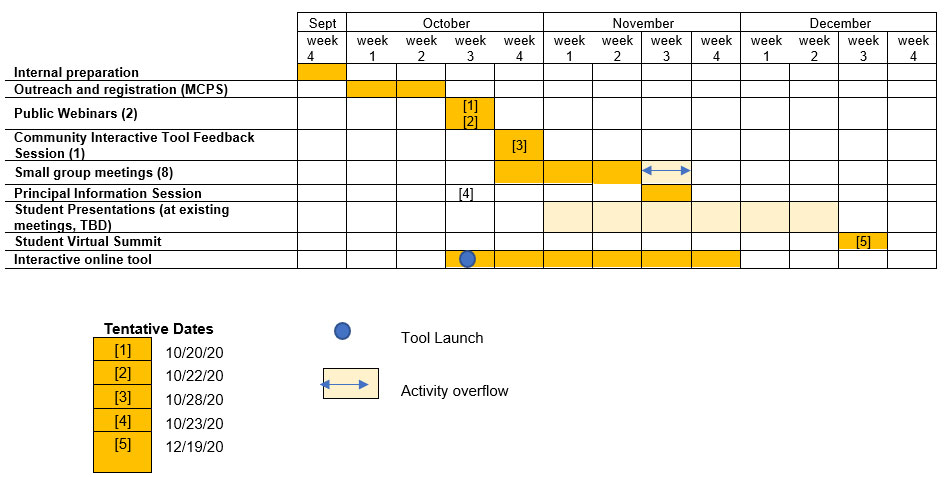Final Boundary Analysis Report Released
External consultant WXY Architecture + Urban Design has provided the Montgomery County Board of Education with a final report assessing Montgomery County Public Schools’ boundaries as part of a comprehensive Districtwide Boundary Analysis. The nearly 200-page document includes an in-depth analysis of school utilization, school diversity, student proximity to school, and student assignment stability. The report process also reviewed boundary benchmarking data from other school districts and includes a summary of community engagement.
IMPORTANT NOTE: The purpose of the Boundary Analysis work was to examine existing conditions in the district and provide a critical data resource for the Board of Education that will allow them to comprehensively understand districtwide issues informed through data and community feedback and guide future boundary considerations. The final report does not make any boundary recommendations.
Read the Final Boundary Analysis
Key Findings of the Boundary Analysis
English / español / 中文 / français / Português / 한국어 / tiếng Việt / አማርኛ
Phase 2 Engagement
Boundary Analysis: Interactive Tool
Remind Me … What’s the Districtwide Boundary Analysis Again?
The Districtwide Boundary Analysis is an initiative designed to provide a comprehensive assessment of Montgomery County Public Schools (MCPS) boundaries by analyzing data points, such as school facility utilization and capacity, student demographics and proximity to schools. The initiative builds upon MCPS’ engagement efforts from the spring of 2019 and will continue to involve community members through a series of forums to fully understand the challenges in creating more meaningfully integrated and culturally responsive schools within Montgomery County.
Why Is It Important to Do Now?
In the past 20 years, MCPS enrollment has increased by more than 30,000 students. This growth has helped MCPS become one of the largest and most diverse districts in the nation. Unfortunately, facility construction has not kept pace with this significant growth. The overcapacity of many schools, paired with a continued focus on equity and excellence, prompted the Board of Education to initiate an assessment of current school boundaries to ensure that MCPS can continue to provide high-quality facilities that support the educational programming needed to reinforce its core values of Learning, Relationships, Respect, Excellence and Equity.
What Has Happened So Far?
Before the COVID-19 crisis hit, we had just completed Phase I of our engagement process and analysis. This culminated with an interim report in March 2020.
Phase I engagement included:
- Board of Education public hearing – November 2019
- Regional open meetings across the county—December 2019-January 2020
- Gaithersburg High School
- Julius West Middle School
- White Oak Middle School
- Walter Johnson High School
- Montgomery Blair High School
- Northwest High School
- 12 targeted outreach/engagement sessions with hard-to-reach communities and other key stakeholders (January-March 2020)
What Is In Store for Phase II Engagement?
The consultant team, WXY Studio, is developing an Interactive Boundary Explorer to support residents and stakeholders in conducting a deeper exploration of MCPS schools. The tool allows participants to understand the three lenses—utilization, diversity and proximity—from the individual school to the district as a whole, while enabling them to explore relationships between clusters located next to one another at a deeper level.
Phase II is centered around engaging as many county residents and stakeholders as possible in the use of this interactive tool and gaining robust input and feedback, centered around key questions:
- How well do you think utilization, diversity and proximity are balanced between your school and its nearby schools?
- Are there geographic areas of the county where you see significant challenges with school boundaries? If so, where and what kinds of challenges?
- Which school levels (elementary, middle, high) do you think have the greatest challenges with school boundaries? What kinds of challenges?
- Which schools or groups of nearby schools do you think have the greatest challenges with school boundaries? What kinds of challenges?
- Are there any schools, clusters or parts of the county where you see an opportunity to balance utilization, diversity and proximity? Where and how?
Throughout this process, the team will also collect broader insights about the public’s priorities related to school boundaries, and how these might have shifted during the COVID-19 pandemic.
Phase II engagement will take place virtually during the fall of 2020 and will include:
-
Public Meetings
- Two Public Webinars: These will provide a full orientation to the interactive tool and allow participants to conduct initial, individual exploration. The webinars will be available on the MCPS website for those who cannot attend.
- Community Interactive Tool Feedback Session: This will allow participants to exchange findings from their time exploring the interactive tool and share feedback in facilitated virtual conversations.
-
School Community Engagement
- Principal Engagement: The team will engage principals and assistant principals in exploring the interactive tool and equip them to share the process with their teachers, staff, and students.
- Student Engagement: The team will develop exercises for middle and high school students using the interactive tool. There will be a virtual training session for teachers and principals on integrating the interactive tool into virtual learning, and a student-only virtual session.
-
Targeted Engagement
- Targeted Small Group Meetings: These meetings will be held with constituencies who do not typically participate in community engagement processes because of lack of availability, lack of transportation, language and literacy challenges, or other barriers.
-
Online Survey
- Participants in all of the above activities will be encouraged to interact with the interactive tool and complete the online survey on the website. This survey will serve as a primary mechanism for collecting and reporting findings to the BOE.
How Will The Outcomes Be Used?
Feedback the consultant team gathers will be included in the final report and presented to the Board of Education to inform future planning on school boundaries. Once complete, this report will serve as a critical data resource for Board members and will allow them to comprehensively understand districtwide issues informed through data and community feedback. The final report will not have any recommendations on boundary changes.
Purpose
The Districtwide Boundary Analysis is an initiative designed to provide a comprehensive assessment of Montgomery County Public School boundaries by analyzing various data points such as school facility utilization and capacity, student demographics, school assignment and travel patterns. The initiative builds on MCPS’s engagement efforts from Spring 2019 and will continue to involve community members from all backgrounds through a variety of forums to fully understand the spectrum of challenges towards creating more meaningfully integrated and culturally responsive schools within Montgomery County.
Why Now?
Over the twenty years, student enrollment at Montgomery County Public Schools (MCPS) has increased by more than 30,000 students. This growth has helped MCPS become one of the largest and most diverse districts in the nation. Unfortunately, facility construction has not been able to keep pace with this significant growth. The overcapacity of many schools, paired with our continued focus on equity and excellence, prompted the Board of Education to initiate an assessment of current school boundaries to ensure that MCPS can continue to provide high-quality facilities that support the educational programming needed to reinforce MCPS’s core values of Learning, Relationships, Respect, Excellence, and Equity.
The Facts About the Districtwide Boundary Analysis (A letter from Board President Shebra Evans and Superintendent Jack Smith – Dec. 11, 2019)
IMPORTANT NOTE:
This initiative will result in an analytical assessment and a summary of the community engagement process. It will not make recommendations on potential boundary revisions.
What Comes Next

Districtwide Boundary Analysis
Focus Areas
Equity:
- Student Body Demographics
- Socio-Economic Equity
Capacity:
- Facility Utilization and Capacity
- School Articulation and Feeder Patterns
- School Assignment Stability
Access:
- Geographic Proximity to Schools
- Existing School Bus Transportation Patterns
Districtwide Boundary Analysis
Guiding Principles
The two major components of the initiative will adhere to some key principles identified below:

1 Data Analysis
- Contextualize analyses
to issues raised through engagement activities - Eliminate data and research bias
by comparing findings to other relevant school districts - Create comprehensive models
that examine opportunities and trade-offs between key performance indicators

2 Community Engagement
- Utilize innovative communication and outreach strategies
to maximize participation from all corners of the county - Foster an inclusive environment at all engagement activities
to ensure that people from diverse racial, ethnic, cultural and economic backgrounds feel welcomed - Encourage participation
through carefully crafted workshop-type activities - Share analytical findings
through various mediums that demystify data analyses and ensure tangible outcomes from engagement activities - Create a feedback loop
by using variety of online survey tools
Resources
District Boundary Analysis Archive
- Timeline for the Development of Board Policy FAA
- WXY-Scope Documents and RFP
- The Facts About the Districtwide Boundary Analysis Dec. 11, 2019
- Awarded Contract for Districtwide Boundary Analysis (August 29, 2019)
- Boundary Analysis Request for Proposal (RFP) (July 15, 2019)
- Boundary Assessment Study Given Revised Policy FAA, Educational Facilities Planning (Jan. 8, 2019)
- Policy FAA
- Division of Capital Planning
- Districtwide Boundary Analysis Communications Plan: Outline of Activities (Oct. 2019)